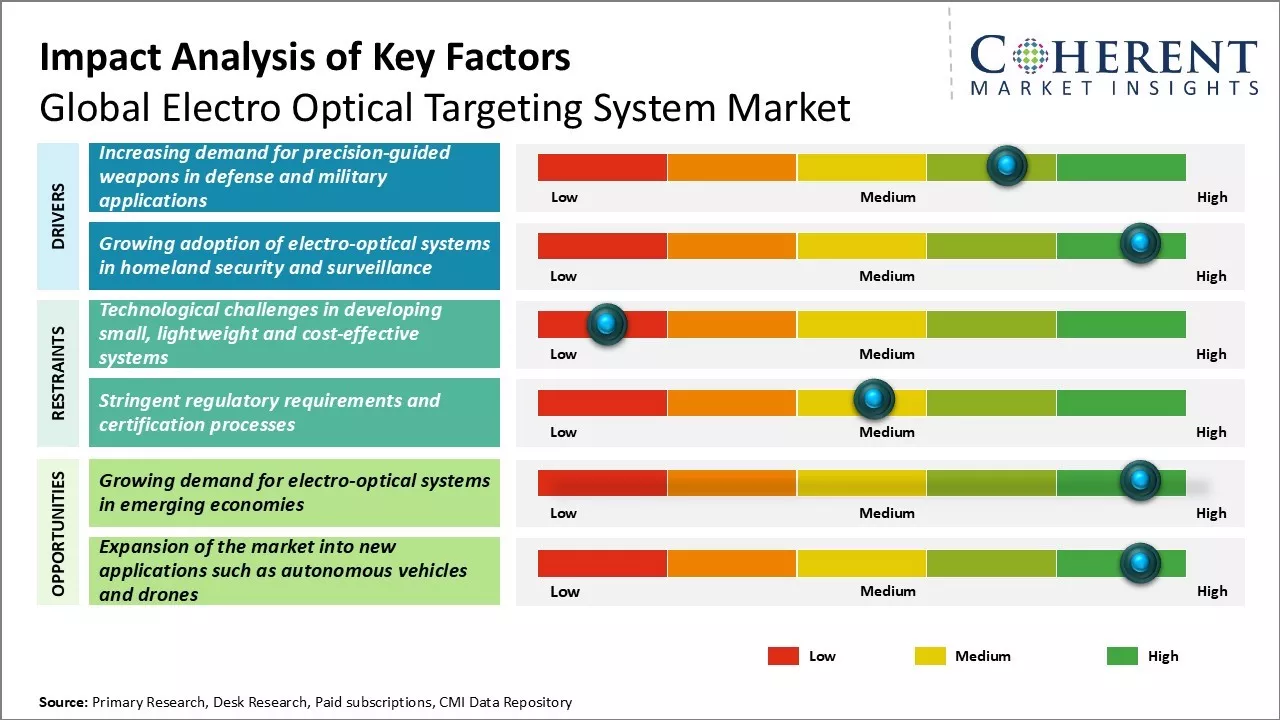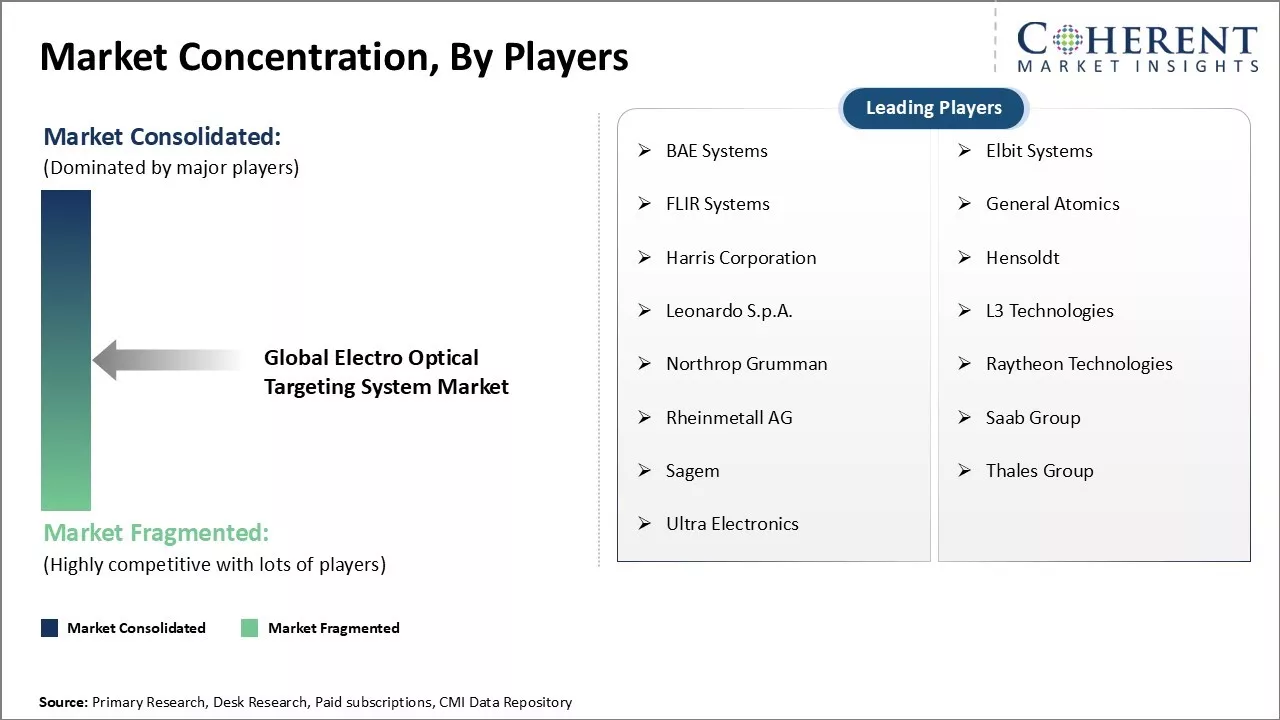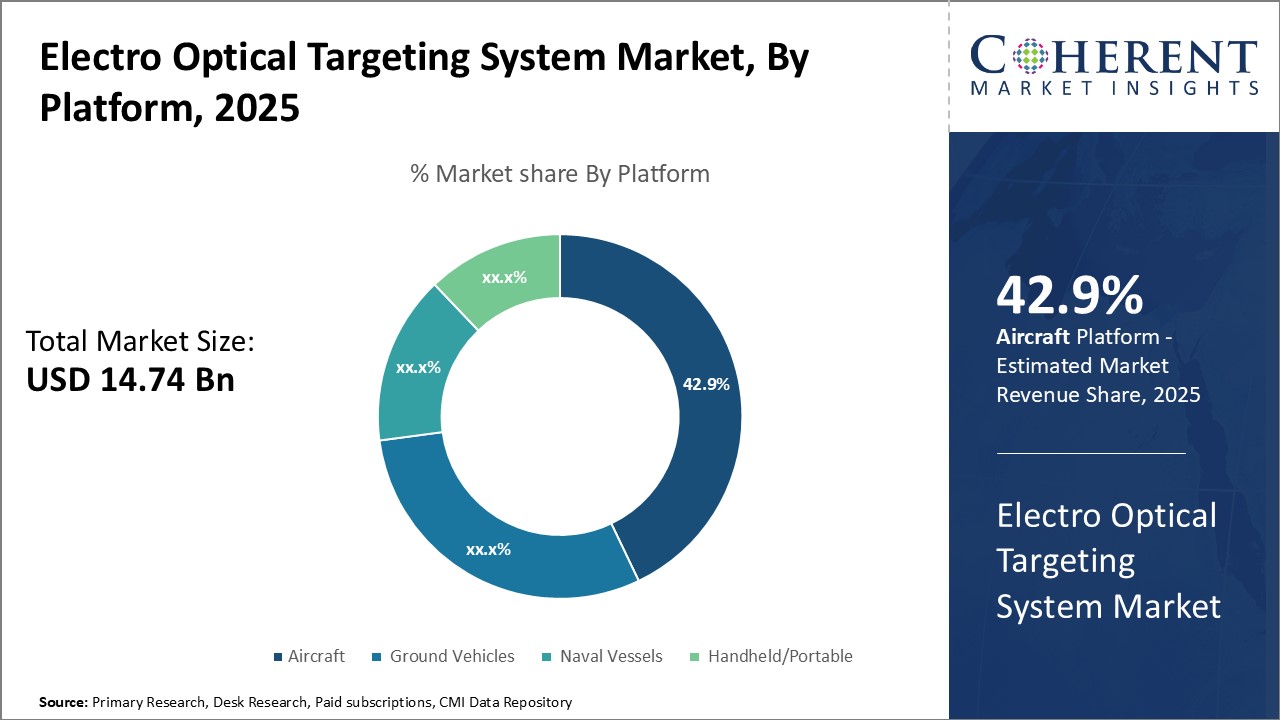Electro Optical Targeting System Market Size and Trends
Global electro optical targeting system market is estimated to be valued at USD 14.74 Bn in 2025 and is expected to reach USD 20.60 Bn by 2032, exhibiting a compound annual growth rate (CAGR) of 5.6% from 2025 to 2032.

Discover market dynamics shaping the industry: Download Free Sample
Increasing demand for precision-guided weapons in defense and military applications
Rising geopolitical tensions and increasing conflicts across various regions have prompted many countries to extensively modernize and strengthen their military weapons systems. With technologically advanced enemies, there has been growing need to minimize collateral damage and improve hit accuracy during operations. Electro optical targeting systems play a crucial role in fulfilling this need by enabling precision-guided missiles, bombs and ammunition. These systems offer day and night targeting capabilities using infrared, laser and optical technologies to accurately detect, track and engage targets from long ranges.
Most nations are now procuring new generations of missiles like cruise missiles and air-to-surface missiles that greatly rely on electro optical sensors for navigation and terminal guidance. Countries want to develop precision strike abilities to neutralize enemy infrastructure and installations from stand-off distances while avoiding non-combatant casualties. This has boosted demand for electro optical targeting systems that can continuously monitor a designated target area, detect imminent threats and guide weapons to impact points within meters of accuracy regardless of weather or lighting conditions. With ongoing modernization programs, militaries also aim to retrofit existing weapons with updated targeting pods and sights to improve their effectiveness over the long term.
Growing tensions along borders and rising maritime security issues have led many defense agencies to acquire new electro-optical payloads for surveillance systems. Unmanned aerial vehicles are being increasingly configured with day-night sensor turrets to monitor borders and coastal areas. Likewise, warships and patrol vessels are equipping with infrared and thermal cameras integrated onto small and medium-caliber weapon stations to detect, identify and potentially engage threats from long distances at sea under all conditions.
For instance, In February 2021, Elbit Systems Ltd., an Israel-based defense electronics company that develops and supplies a wide range of airborne, land, and naval systems for defense, homeland security, and commercial applications, announced that it had secured a contract worth approximately $82.0 million from BAE Systems Hägglunds AB, a subsidiary of the multinational defense, security, and aerospace company BAE Systems. The contract involves providing the Royal Netherlands Army with electro-optical commander sights and active protection systems.
Market Concentration and Competitive Landscape

Get actionable strategies to beat competition: Download Free Sample
Growing Adoption of Electro-Optical Systems in Homeland Security and Surveillance
With evolving national security dynamics, governments worldwide are putting greater emphasis on enhancing their surveillance capabilities to monitor activities within land and maritime borders. Electro optical systems have emerged as valuable tools to aid round-the-clock situational awareness and response times of law enforcement and security agencies. Thermal cameras, day-night sensors and laser rangefinder systems are being integrated extensively onto ground patrol vehicles, helicopters, aerostats and unmanned aircraft for border monitoring missions. Coupled with analytics, these aids provide an all-weather reconnaissance capability to detect intrusions, track suspicious movements and assist rapid intervention if required.
Electro-optical payloads witness huge popularity for video surveillance and security applications around critical infrastructure, public venues, city perimeters and energy/industrial facilities. Thermal cameras with high sensitivity and zoom capabilities allow real-time monitoring of broad areas under total darkness for early warning of intruders. When paired with automatic threat-recognition, these systems can autonomously alert control rooms of potential threats. Integrating electronics onto surveillance towers and mini-UAVs further scan larger perimeters even in remote regions. With changing security dynamics, countries are now implementing multisensory surveillance grids using electro-optical systems to boost protection across their territories from natural disasters and criminal activities.
Key Takeaways from Analyst:
Global electro optical targeting system market growth is driven by increasing defense modernization programs worldwide. Rising geopolitical tensions and emphasis on strengthening military capabilities prompt nations to invest significantly in procuring more advanced targeting systems. Growing utilization of electro optical targeting pods in combat and multi-role aircraft for intelligence, surveillance and reconnaissance missions can drive the market growth.
North America currently dominates the market, owing to large-scale military modernization programs undertaken by the U.S. and Canada. However, growing defense budgets and rising indigenous weapon system development in Asia Pacific economies such as China and India can provide significant opportunities in the near future.
Increasing installation of electro optical systems on unmanned aerial vehicles and helicopters for both military and commercial applications can open up new revenue streams for manufacturers. Adoption of infrared, laser and multi-sensor integrated variants will gain traction as these offer enhanced tracking, precision targeting and navigation capabilities compared to traditional systems. Ongoing technological advancements in miniaturization, sensing, imaging technologies and network-enabled features can expand the scope of electro optical targeting systems.
Market Challenges: Technological challenges in developing small, lightweight and cost-effective systems
Global electro optical targeting system market growth can be hampered due to technological challenges in developing small, lightweight and cost-effective systems. As defense forces aim to downsize their operational footprint and become more agile, there has been increasing demand for compact electro optical targeting pods that can be easily integrated into smaller aircraft and unmanned aerial vehicles. However, miniaturizing these complex systems while maintaining high performance capabilities is technically very challenging. The numerous optical, infrared and laser components integrated into modern targeting pods produce a lot of heat, which needs effective thermal management within a small form factor. Meeting stringent military durability and reliability standards with smaller and lighter units also poses design and engineering difficulties. Cost is another major constraint as expanding procurement budgets do not always cover the high R&D investments required to develop next-generation compact targeting technology. Unless manufacturers find innovative material, sensor and thermal management solutions, the demand for smaller and affordable electro optical systems may remain partially unmet.
Market Opportunities: Growing demand for electro-optical systems in emerging economies
Global electro optical targeting system market witness significant opportunity due to growing demand from emerging defense economies. Countries like India, Brazil, Indonesia, Turkey and others are modernizing their armed forces with new aircraft, helicopters, UAVs and armored vehicles. As these nations aim for greater self-reliance and operational independence, there has been rising need for enhanced targeting, surveillance and reconnaissance capabilities. Electro optical targeting pods allow modern military platforms to precisely acquire, track and engage targets during day and night operations. With their budgetary allocations rising, many emerging economies now have the means to procure sophisticated electro optical targeting systems in large numbers. Leading global defense majors are aggressively marketing their latest technologies to these new markets. If original equipment manufacturers can offer competitive pricing and financing options, there has been huge potential for electro optical system sales in developing nations for future revenue growth in the near future.

Discover high revenue pocket segments and roadmap to it: Download Free Sample
Insights By platform - Aircraft Segment Dominance Driven by Strategic Military Importance
Aircraft segment is estimated to contribute the highest market share of 42.9% in 2025, owing to their strategic importance. Aircraft play a vital role in modern warfare, enabling aerial surveillance, reconnaissance, troop support, and precision strikes from above. This affords military planners unparalleled visibility of battlefields while keeping pilots out of harm's way. Electro optical targeting systems allow aircraft to accurately identify targets day or night using infrared cameras, laser rangefinders, and other sensors. With high resolution imagery and tracking capabilities, these systems empower aircraft to direct weaponry with pinpoint accuracy from stand-off ranges or support troops engaged in ground operations. Their ability to provide real-time intelligence from the air makes aircraft uniquely suited for border protection, counterinsurgency, and homeland defense as well. With conflicts increasingly relying on air power, leading militaries continue investing heavily in precision-guided munitions that require sophisticated onboard targeting systems for guidance. This boosts demand for continuous upgrades and new variants of electro-optical systems specialized for different aircraft types and missions.
By Application- Dominance of the ISR Segment Due to Strategic Necessity in Modern Warfare
Intelligence, surveillance, and reconnaissance (ISR) segment is estimated to contribute the highest market share of 45.1% in 2025, due to its vital role across all military domains. Modern warfare depends upon obtaining timely situational awareness of adversaries to gain tactical and strategic advantages. Electro optical targeting systems mounted on manned and unmanned platforms enable forces to closely monitor regions of interest without exposing personnel. Thermal cameras and other sensors empower round-the-clock surveillance of infiltrator routes, hostile encampments, and infrastructure critical to military operations. During conflicts, these systems provide vital imagery intelligence to commanders for decision making through constant monitoring of enemy troop movements and weapons deployments. These also help security forces counter threats through border and coastal monitoring as well as search and rescue missions during humanitarian relief efforts. As new surveillance technologies emerge, militaries continuously modernize their toolbox of ISR systems to keep pace with evolving threats.
By End User - Military Segment Dominance Driven by Core Defense Responsibilities
Military segment is estimated to contribute the highest market share of 54.7% in 2025, due to defense being their core responsibility. For armed forces worldwide, maintaining operational readiness through advanced targeting equipment ranks among top spending priorities. Electro optical systems take on increasing importance as kinetic warfare evolves into more precise engagements from extended ranges. Modern fire control systems require integration with laser designators, thermal cameras and other sensors to synchronize targeting across land, air, sea and space-based assets. Militaries invest heavily in such multi-spectral targeting suites for combat vehicles, warships, helicopters and ground stations to expand their operational domains. These also outfit dismounted troops with portable targeting systems for acquiring targets in urban combat zones. As militaries pursue network-centric warfare capabilities through ambitious modernization plans, there will be increase in spending on cooperative engagement technologies and interoperable targeting solutions. This boosts demand for military-grade electro-optical targeting systems optimized for multiple domains and missions.
Regional Insights

Need a Different Region or Segment? Download Free Sample
North America currently dominates the global electro optical targeting system market with an estimated market share of 33.6% in 2025, due to strong military budgets and early adoption of advanced targeting technologies across major armed forces in the U.S. and Canada. The region is home to leading defense prime contractors like Lockheed Martin, Boeing and Northrop Grumman who have decades of experience in developing electro optical targeting systems. These companies have partnered with the Pentagon to equip their vast fleet of fighter jets, attack helicopters and armored vehicles with precision targeting capabilities.
Asia Pacific region has emerged as the fastest growing market for electro optical targeting systems. Countries like China, India, Japan and South Korea are aggressively investing in their indigenous defense industries to reduce foreign dependency. Homegrown companies in Asia Pacific have increased their R&D efforts and forged strategic international alliances to quickly localize high-end technologies. For example, several Chinese state-run enterprises have partnered with Russian counterparts to co-develop next-gen targeting pods for the J-20 stealth fighter. Meanwhile, "Make in India" initiative has lured global OEMs to set up export hubs and transfer critical targeting technologies to Indian partners. This has made APAC an attractive sourcing base with competitive pricing. Rapid modernization of armed forces across the Indo-Pacific region can also drive the APAC electro optical targeting system market growth in the future.
Market Report Scope
Electro Optical Targeting System Market Report Coverage
| Report Coverage | Details | ||
|---|---|---|---|
| Base Year: | 2024 | Market Size in 2025: | USD 14.74 Bn |
| Historical Data for: | 2020 To 2024 | Forecast Period: | 2025 To 2032 |
| Forecast Period 2025 to 2032 CAGR: | 5.6% | 2032 Value Projection: | USD 21.60 Bn |
| Geographies covered: |
|
||
| Segments covered: |
|
||
| Companies covered: |
BAE Systems, Elbit Systems, FLIR Systems, General Atomics, Harris Corporation, Hensoldt, Leonardo S.p.A., L3 Technologies, Northrop Grumman, Raytheon Technologies, Rheinmetall AG, Saab Group, Sagem, Thales Group, and Ultra Electronics |
||
| Growth Drivers: |
|
||
| Restraints & Challenges: |
|
||
Uncover macros and micros vetted on 75+ parameters: Get instant access to report
Market Segmentation
- By Platform Insights (Revenue, USD Bn, 2020 - 2032)
-
- Aircraft
- Ground Vehicles
- Naval Vessels
- Handheld/Portable
- By Application Insights (Revenue, USD Bn, 2020 - 2032)
-
- Intelligence, Surveillance, and Reconnaissance (ISR)
- Targeting
- Weapon Guidance
- Others
- By End User Insights (Revenue, USD Bn, 2020 - 2032)
-
- Military
- Homeland Security
- Law Enforcement
- Others (Research, Commercial, etc.)
- By Regional Insights (Revenue, USD Bn 2020 - 2032)
- North America
- U.S.
- Canada
- Latin America
- Brazil
- Argentina
- Mexico
- Rest of Latin America
- Europe
- Germany
- U.K.
- Spain
- France
- Italy
- Russia
- Rest of Europe
- Asia Pacific
- China
- India
- Japan
- Australia
- South Korea
- ASEAN
- Rest of Asia Pacific
- Middle East
- GCC Countries
- Israel
- Rest of Middle East
- Africa
- South Africa
- North Africa
- Central Africa
- North America
- Key Players Insights
-
- BAE Systems
- Elbit Systems
- FLIR Systems
- General Atomics
- Harris Corporation
- Hensoldt
- Leonardo S.p.A.
- L3 Technologies
- Northrop Grumman
- Raytheon Technologies
- Rheinmetall AG
- Saab Group
- Sagem
- Thales Group
- Ultra Electronics
Share
Share
About Author
Raj Shah is a seasoned strategy professional with global experience, from strategy to on-the-ground operational improvements. In last 13 years, he has executed number consulting projects focused on consumer electronics, telecom and consumer-internet business leading multiple long-term engagements towards mobilizing and executing on break-through strategy - leading to tangible sales results. Raj is also acting as a strategy consultant for one of the leading online hyper local service providers in India, contributing to their growth through critical strategic decisions. Raj usually spends time after office in talking to the passionate entrepreneurs, regardless of their funding status.
Missing comfort of reading report in your local language? Find your preferred language :
Transform your Strategy with Exclusive Trending Reports :
Frequently Asked Questions
EXISTING CLIENTELE
Joining thousands of companies around the world committed to making the Excellent Business Solutions.
View All Our Clients

